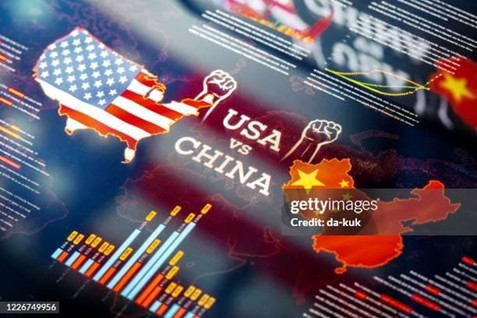Trump And Tariffs: How Us Trade Policy Affects The World
July 21, 2025 2025-07-21 9:52Trump And Tariffs: How Us Trade Policy Affects The World

Trump And Tariffs: How Us Trade Policy Affects The World
By Dhruvah Sreedhar
Source: Da-kuk on Getty Images
Abstract
Since his return to the White House in January 2025 to serve a second term as President, US President Donald Trump has announced and implemented a series of tariffs targeting the country’s top trade partners- China, Canada and Mexico, along with threats to impose reciprocal tariffs on every country that the US trades with. Arguing that the United States’ large bilateral trade deficits with its trade partners ‘unfair’ and insisting that they are ‘ripping off’ the US, Trump thus far has imposed a 25% tariff on all goods from Mexico and Canada (with a 10% tariff on Canadian oil and energy products), a 20% tariff on goods from China and a 25% tariff on all steel and aluminium imports. This article attempts to provide the context behind these decisions along with their implication for global trade.
Trade, Tariffs and Comparative Advantage
Ideas and practices concerning trade of goods and services has changed through the centuries. Tariffs, or taxes on imports of foreign goods, have been used since ancient times as measures
of boosting state revenue and controlling patterns of trade flows. Today, the most influential theory concerning international trade is the theory of comparative advantage. First introduced by David Ricardo in 1817, comparative advantage in its most basic form says that when two countries trade with each other, both countries can be made better off in terms of total goods available by choosing to specialize in the production of the commodities they are relatively better at making while trading to obtain what they are relatively worse at making. To illustrate, suppose there are two countries- A and B. A produces 120 units of bread and 100 units of butter in 12 hours , while B produces 90 units of butter and 80 units of bread in 12 hours . Clearly, A is better than B at producing both bread and butter. Despite this, both countries could benefit from trade by specializing in what they are relatively better at producing (bread for A and butter for B) and trading to get the other good. This is because for A the opportunity cost of producing butter (1.2 bread) is higher than B’s (0.88 bread) and the reverse of this is true for both of their opportunity costs of producing bread. This insight played a crucial role in dismantling a previously held mercantilist belief – the idea that trade is a zero-sum game, ie someone’s gain implies someone else’s loss. It is still viewed as one of the strongest arguments in favour of free trade and low tariffs. With that said, it should be noted that the theory doesn’t claim that free trade would be beneficial for everyone. People within nations whose livelihoods depend on producing goods that may be more efficiently produced elsewhere would be adversely affected by freer trade. This would have important distributional consequences that may not be seen as desirable on the whole.
Trade Post-World War 2
Following the damage inflicted on countries around the world as a result of WW2, 44 nations agreed to participate in the formation of a new global economic order that would aim to design institutions and mechanisms to assist post-war recovery and strengthen economic ties between nations. The system, in reference to Bretton Woods, New Hampshire where the meetings
between the nations were held, came to be known as Bretton Woods. While Bretton Woods itself was mostly concerned with financial and monetary matters, it was accompanied and supported by a broader emphasis on the role of multilateral institutions for maintaining world peace. For international trade, the most significant of these institutions was the General Agreement on Tariffs and Trade (GATT). The several trade agreements that would be passed in the years to come under this framework, in line with Ricardo’s idea of comparative advantage, aimed to liberalize trade flows between nations by reducing tariffs and restricting quotas. Global trade did in in fact increase significantly post World War 2. Real exports in 1997 were roughly14 times what they were in 1950. The World Trade Organization (WTO) formed in 1995 during a time of market optimism among Western countries – neoliberalism or the Washington consensus as its sometimes called – introduced a harsher enforcement mechanism for free trade principles. By this time, China was starting to emerge as a dominant trade power through its careful combination of state interventions through currency devaluation, heavy subsidies and capital controls with market-oriented incentives and openness to foreign investment. China’s transformation to a manufacturing powerhouse was thus aided by the liberal global trade order which promoted the free flow of goods, services and capital across borders. In the process, it became a major exporter of goods to the United States and the preferred location for many American companies’ manufacturing centres due to lower labour and compliance costs. This practice of offshoring production to foreign countries and importing their cheaper products undermined domestic industries in the US and set the stage for the election of Trump in 2016.
Trump’s First Term, Trade War with China
Donald Trump’s ascent to power in 2016 as a result of the US elections marked a shift in the direction of US trade policy – from an optimistic view of the ability of free trade to benefit all parties involved, to a view that promoted the use of tariffs as tools of negotiation to further
unilateral interests. His election may be interpreted as a manifestation of a broader display of scepticism shown by Western countries regarding the extent of globalization that had taken place in the preceding decades. In the United States’ case, issues such as stagnation of wages, offshoring of manufacturing jobs and income inequality came to be perceived as resulting from the high level of US imports from its trade partners, strengthening the appeal of Trump’s pitch to renegotiate trade agreements and put American interests first. Accordingly, he imposed a 30- 50% tariff on washing machines and solar panels and set off a trade war with China by targeting roughly $350 billion worth of imports, claiming they were guilty of unfair trade practices and intellectual property theft. China responded with tariffs of their own, targeting $100 billion worth of goods from the US. The chart below shows how trade relationships for both countries have changed since the trade war.

Source: Bloomberg (Bloomberg Economics, https://www.bloomberg.com/graphics/2025-trump-china-new-trade-war/.)
Both countries have reduced their dependence on each other with China’s share of total US trade (measured as the sum of goods exports and imports) from 2018 to 2024 dropping from
15.7% to 10.9%, and the US’s share in China’s trade falling from 13.7% to 11.2%1. China is now the source of only 18% of US imports as opposed to its previous 22% before the trade war2. China’s trade surplus with the US remains the world’s largest but has been declining. The Biden administration-maintained Trump’s tariffs and layered on various export controls designed to curb Beijing’s access to key technologies.
Trump 2.0 and Present Scenario
The context on global trade established thus far allows President Trump’s current actions on trade to be interpreted as further steps that aim to restructure the global post ww2 trade order, from a multilateral rules based order guided by principles of free trade and comparative advantage, to a more fragmented order that places transactional interests at the forefront, guided by protectionist views to support domestic industries and jobs. Given the United States’ role as the largest source of global demand for goods and services (as indicated by chart below) and the highly interconnected nature of global trade, this shift is bound to produce significant consequences affecting every country.

1 How Trump’s First Trade War with China Gave Rise to New Targets: Bloomberg (2025).
2 Four years into the trade war, are the US and China decoupling? Peterson Institute for International Economics (2022).
US has the highest current account deficit in the world, implying its role as an important source of global demand.
The global trade order is a complex system with several interlinkages that evolve and adapt to change in unpredictable ways. This makes the task of trying to estimate the precise effects of tariff increases on inflation, economic growth, jobs and other economic variables for different countries arduous and unreliable. With that said, given the structure of global trade as it exists today, some general implications may be drawn out.
Global Value Chains

A global value chain (GVC) refers to the network of inter-country trade linkages involved in the development, marketing, production and distribution of a product. It involves the movement of intermediate goods across several borders for the creation of a single product. According to
OECD, approximately 70% of international trade takes place through GVCs3. Given their importance, the effect of tariffs from the US may be discussed keeping in mind their effect on GVCs.

3 Global value and supply chains: OECD.
Effect of US tariffs on Mexico from a GVC perspective
The illustration above shows how the costs of a tariff imposed by the US on Mexican goods passesthrough the cross-border supply chain, affecting different parties differently depending on the extent to which they absorb the final burden. For example, the costs incurred by American importers from a higher tariff on Mexican intermediate goods may be passed on to American consumers, through sale of final goods and/or to other countries through exports. Higher prices on US exports would in turn affect Mexico which gets 44% of their backward linkages from the US4 . At the same time, higher costs would also affect demand for those goods and thus could impact the margins of the parties passing on the costs (Mexican exporters and American importers in this case), if they choose to do so rather than bear the loss themselves. Lower demand for these intermediate exports from Mexico would also affect
4 The Integration of Mexico in Global Value Chains: Opportunities and Challenges (2022).
Mexican domestic industries and the backward linkages that supply these inputs, affecting the countries from which they get them and so on. The diagram also shows that the higher costs of US intermediate exports to Mexico (or other countries) can loop back to the US itself due to the interconnected nature of global value chains (intermediate exports from US may be used by Mexico for making other intermediate goods or final goods that are again imported by the US). Indeed, a study by rabobank.com shows that global value chain integration of US firms is most prominent in three Mexican industries: motor vehicles (18.1%), electronic equipment (17.2%) and electrical machinery (16.7%). For example, for the Mexican motor vehicles industry, this means that 18.1% of final exports from Mexico to the US consists of American value added5. Extending this way of looking at trade linkages to other major trade partners on which the US has imposed tariffs, Canada and China for example and on which the US plans to impose retaliatory tariffs, like India and the EU, we can see how tariff changes can cascade along global value chains with implications for countries involved directly and indirectly.
The goal of such a policy, from the US’s perspective, would be to encourage purchases of goods from domestic industries. Given that intermediate exports, final exports and domestic final goods made using inputs from Mexico now cost more due to the tariffs, it would incentivize consumption of inputs and final goods coming from American firms as they can supply these goods without having to pass on costs or bear losses due to tariffs. Demand for more American made goods, particularly in the manufacturing sector, could mean more jobs and/or higher incomes for working class Americans. The difficulties with this however, apart the transition costs and linkage issues discussed above, arise from the output and efficiency losses that would ensue for the US as a result of having to forgo the gains from comparative advantage. Different countries having different distributions of labour, capital and resources can increase total output of goods and services for one another by specializing in what they are good at and trading what
5 US global value chain integration: a major impediment for Trump’s protectionist trade agenda (2017).
they are relatively worse at. In the US’s case, this has meant focusing on high-value, capital- intensive activities while offshoring labour-intensive manufacturing jobs to other countries. Trying to reverse this would have effects on output and distribution of income. What the net effect of these changes would be for the US or the world as a whole is uncertain and remains to be seen.
Conclusion
In conclusion, the new round of tariffs imposed by US President Donald Trump aims to reshape global trade by altering what the US perceives to be decades of unfair treatment at the hands foreign nations’ trade policies that he believes have exacerbated US trade deficits and rendered their manufacturing sector and the jobs associated with it stagnant. The move rejects the economic logic of comparative advantage, placing distributional and unilateral concerns at the forefront. The stress this will place on global value chains is likely to be significant, implying a disruptive and uncertain readjustment process for countries around the world. These events also make clear the inherently political nature of economic decisions. Whatever outcome a theory may suggest when viewed as an abstract model, when the time comes to make a decision, theory alone cannot provide definite answers of what the best decision is. Theory may be used to inform decision-making, but the choice itself comes down to the convictions of the decision-maker and the values he chooses to embody.
Bibliography
Bown, Chad P. “Four years into the trade war, are the US and China decoupling?” PETERSON INSTITUTE FOR INTERNATIONAL ECONOMICS,
https://www.piie.com/blogs/realtime-economics/2022/four-years-trade-war-are-us- and-china-decoupling.
Erken, Hugo. “US global value chain integration: a major impediment for Trump’s protectionist trade agenda.” Rabobank, https://www.rabobank.com/knowledge/d011322666-us-global-value-chain- integration-a-major-impediment-for-trumps-protectionist-trade-agenda.
Flach, Prof. Dr. Lisandra, and Dr. Feodora Teti. “The Integration of Mexico in Global Value Chains: Opportunities and Challenges.” ifo Center for International Economics. https://www.kas.de/documents/266027/23210398/The+Integration+of+Mexico+in+Gl obal+Value+Chains+Opportunities+and+Challenges_KAS_M%C3%A9xico_ifo_com pressed.pdf/18c5a99f-afda-aaa9-ddf1-afd10b14380e?version=1.0&t=1678385287714. Organisation for Economic Co-operation and Development. “Global value and supply chains.” OECD, https://www.oecd.org/en/topics/policy-issues/global-value-and-supply-chains.html.
Saito, Yasufumi, and Malcolm Scott. “How Trump’s First Trade War with China Gave Rise to New Targets.” Bloomberg Economics, https://www.bloomberg.com/graphics/2025- trump-china-new-trade-war/.
About the author
Dhruvah is a first-year undergraduate student studying B.A Economics (Hons.) at Jindal School of Government and Public Policy. His research interests include macroeconomics, economic schools of thought and complexity theory.






